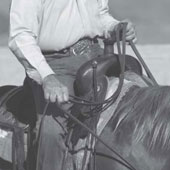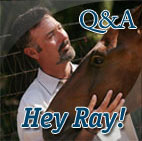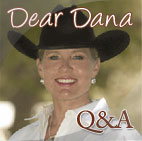Hanging Bridle: A look at sensitivity
 Thirteenth in a series
Thirteenth in a series
After refining cuing zones with our legs last issue, Les helps us toward a lighter touch.
Here’s a good exercise to remind you of how little rein pressure it takes to send a signal to your horse.
To try it, just hang your bridle on a doorknob, like it would hang from a horse’s head. Now stand about five feet away, take one rein in your hand and just lift it until you make contact with the bit and it starts to move. You’ll see that it doesn’t really take a lot of pressure or movement on your part to get movement out of the bit. Our goal is not to force the horse’s movement through the bridle, but to teach him to respond in a certain way when he feels contact, not necessarily pressure, from the bit. The faster you can train yourself to cue him with a lighter touch, the faster you will get the light response we all want to achieve.
Of course your horse is not going to know that he’s supposed to respond to the light cues right away, but it’s important that you always start there, to give him a chance to be a hero and do it right, before you get stronger and more insistent with your cues. One of these times he’s going to surprise the heck out of you!
Throughout this program I’ll be laying out exercises for you to do with your horse. It’s really important that you stay with each one until your horse has reached the point where he’s conditioned to perform the movement perfectly, with just a light cue. If you can do that, over the long run, I know you’ll really be satisfied with your results!
EDITOR’S NOTE: More with Les is a regular California Horsetrader column. Les Vogt has won more than 15 World Championships, including two wins at the NRCHA Snaffle Bit Futurity. Although Les still rides and occasionally shows, his focus is giving clinics around the world and developing products for the performance horseman. To learn more about Les and to see his clinic schedule, visit: www.lesvogt.com
Cuing zones for your legs
 Twelfth in a series
Twelfth in a series
Last issue, Les reviewed responsive leg and foot positions; now, let’s refine our cues.
If you’re going to be effective in controlling the horse’s body parts individually, you’re going to need to refine your cues as much as possible. One way that we do that is by having specific zones on the horse’s belly for your leg cues.
Using Your Legs
 Eleventh in a series
Eleventh in a series
Last issue, Les began a look at communicating with your seat. Now, let’s look at the legs.
I’m often asked: “When I use my legs, should I be kicking or holding them steady?” Well, just as we’ve talked about how you shouldn’t use steady pressure with your reins, I’m not a big believer in steady pressure with your legs either. A large percentage of the time, I’m going to have you bump the horse’s sides with your calves, or what I call your “boot tops.” To use your boot tops, you’ll turn your knee out so your calves can make contact with the horse’s side and then just bump your legs against him.
Learning to bump with your boot tops is going to make a huge difference in how your horse responds to you and how fast he learns. As an example, imagine you were talking with some friends and someone else walks up to get your attention. If he just lays his hand on your shoulder, you would feel it, but you might just keep going with your conversation; but on the other hand, if he comes up and starts poking you in the arm, you’ll probably pay attention. Using your leg on the horse is very similar. If you’re used to using your calf and pressing on the horse’s side, and he ignores you, where do you go? You’re going to have to press even harder or put on a pair of spurs to make your point. On the other hand, if you are bumping him with your boot tops, your cues are going to be a lot harder for him to ignore.
Another advantage of bumping with your boot tops is it will help you stay balanced and relaxed in the saddle. Any time you’re squeezing with your leg, you will probably be bracing with another part of your body to keep yourself balanced. When you’re riding, you always want to stay loose and relaxed, never stiff.
If there is no response to that, I can push my toe up and plant the spur on my horse’s side – then as I push my toe down the spur will roll up against his belly. When your foot is in the stirrup, the stirrup becomes a fulcrum to help you turn your toe up or down and allows you to use your spur for a controlled “roll” against your horse. It makes him pay attention.
As far as stabbing a horse with the spur, I think those days are gone; we don’t see that much anymore. And one of the main reasons is that it makes the horse tense up. When he sees your foot come out to the side as if you’re going to gouge him, he holds his breath and his neck gets stiff, so there goes my performance. So it’s boot tops first, then make contact with the rowel of your spur, and then roll it up if you need to.
As a horse gets further along I’ll just lay my leg on him first, then bump with my boot tops and so on. You always want to give him a chance to respond to the lightest cue – that’s how you get him light!
EDITOR’S NOTE: More with Les is a regular California Horsetrader column. Les Vogt has won more than 15 World Championships, including two wins at the NRCHA Snaffle Bit Futurity. Although Les still rides and occasionally shows, his focus is giving clinics around the world and developing products for the performance horseman. To learn more about Les and to see his clinic schedule, visit: www.lesvogt.com
Sitting in the Saddle
 Tenth in a series
Tenth in a series
After looking at the hands as communication devices, Les focuses on the seat.
To be effective with your leg cues, you need to be straddling your horse with your weight resting on the bottom of your hip bones. You also want to get to where you can stay balanced in the saddle no matter where your leg is on the horse. As we’ll discuss later, you’re going to need to move your lower leg from the spot just behind the horse’s elbow, to move his shoulder, to a position way back on his barrel, the cue to move his hip. So if you feel like you need to use your legs or the stirrups on a regular basis for balance, you’ve got a long way to go before you have the freedom to use them to effectively cue your horse. Keep just enough weight in your stirrups to keep from losing them. Also, if you’re clamping with your knees, you’re liable to vault out of the saddle if your horse stops, just let your legs hang when you’re not using them and keep them relaxed.
Pick up the RPMs: Clucking
Ancient art still works to rev your horse
 Tenth in a series
Tenth in a series
Now that Les has covered the importance of our hands in the last two issues, let’s learn another communication device.
Clucking is a conditioned response. I read somewhere that clucking goes back to Xenophon* – who lived in something like 400 B.C. Anyway, horsemen have been doing it a long time. And it is interesting how clucking makes a difference, as far as bringing up the adrenaline in a horse.
Training Your Hands
Part 2: Finding 'neutral' with no bit contact

 Ninth in a series
Ninth in a series
Last issue, Les started an in-depth look at how to use our hands. We pick up with more keys to communication.
Another thing you’ll need to work on is to develop your hands’ “neutral” position, which needs to become one where there is no contact with the bit. Our goal is to have a horse that yields quickly and smoothly to any pressure – ideally to just the feel of you taking the slack out of the reins – and if you’re used to having contact with the bit all the time, you’ll never get there.
Training Your Hands
It is 'live' hands we're after, right after pick-up
 Eight in a series
Eight in a series
After reviewing reins last issue, we’ll look at how we use our hands in this column and next.
A key component of this program is that you learn to ride with “life” in your hands. What we mean by this is that you never want to just hang on the bit with steady pressure. Any time you pick up (that is, start to take the slack out of the reins) and feel resistance, you’ll want to immediately start working your hands back and forth on the snaffle, or go to soft bumps if you’re using a direct rein, until the horse stops resisting and yields to your hand. If you try to just pull on the horse, you’re really only training the horse to pull back, and in the long run he’s a lot stronger than you are!
Handling Your Reins
 Seventh in a series
Seventh in a series
After reviewing equipment last issue, Les breaks down one of the foundational communication devices.
If you haven’t ridden with them before, the seven-foot split leather reins are going to take some getting used to. To begin with, you’re going to want to cross them over the horse’s withers, then pick up both the direct rein and the tail from the other rein in each hand. It takes a little practice, but you’ll find that by tightening your grip on the tail of the opposite rein you can tighten your reins by sliding your hands away from each other. All you need to do to loosen them is let them slide through your fingers. On the DVD, I also show you a really neat way to gather up a lot of rein in a hurry!
Cavessons: Start pretty loose
 Sixth in a series
Sixth in a series
Les wraps up his equipment checklist with the set-up of the cavesson.
I prefer a stiff rope cavesson, and I like it under the bridle so that it sits about an inch above the snaffle. Make sure that it’s high enough that the bit won’t pinch the horse’s lip against it when you pick up on the rein. Start with a pretty loose cavesson. I like about ¾-inch clearance under the jaw. You want the horse to be able to open his mouth slightly if he wants to. If it’s too tight some horses might shake their heads, or even panic and fall, so don’t introduce it too snug.
Running Martingales: A good fit?
 Fifth in a series
Fifth in a series
Les takes a look at why a martingale serves a purpose in early stages of training.
I will use a running martingale occasionally, and I recommend them for many riders.
I like a heavy leather one, and I want it adjusted so that the rings of the martingale can go all the way to the horse’s throat latch when he’s standing relaxed. That means his head, or your hands, would have to really get up there before the rings actually pulled on the reins. The martingale is not there to pull your horse’s head down; its main function is to add weight and balance to the reins during the learning process.



 Read Columns
Read Columns

